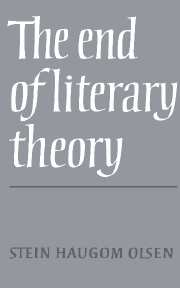Book contents
- Frontmatter
- Contents
- Preface
- Literary aesthetics and literary practice
- Interpretation and intention
- Authorial intention
- Text and meaning
- The ‘meaning’ of a literary work
- Defining a literary work
- What is poetics?
- On unilluminating criticism
- Criticism and appreciation
- Value-judgements in criticism
- Literature, fiction, and reality. A problematic relationship
- Thematic concepts: where philosophy meets literature
- Literary theory and literary aesthetics
- Notes
- Bibliography
- Index
Literary aesthetics and literary practice
Published online by Cambridge University Press: 05 November 2011
- Frontmatter
- Contents
- Preface
- Literary aesthetics and literary practice
- Interpretation and intention
- Authorial intention
- Text and meaning
- The ‘meaning’ of a literary work
- Defining a literary work
- What is poetics?
- On unilluminating criticism
- Criticism and appreciation
- Value-judgements in criticism
- Literature, fiction, and reality. A problematic relationship
- Thematic concepts: where philosophy meets literature
- Literary theory and literary aesthetics
- Notes
- Bibliography
- Index
Summary
ONE
The question ‘What is literature?’ is the starting-point of literary aesthetics. The question is not a request for information about what texts are literary works. It is asked by those who know literature and know the literary canon. Nor does the question merely ask for a definition of literature. The motivation for asking and the interest in possible answers can only be understood against a cultural background where literature figures as an important cultural value. What is asked for is an account of the characteristic features and functions of literature. It is expected that in explaining these, the account should also explain why it is worthwhile to single out certain texts as literary works. It must display those features which define and justify that interest which members of the culture take in its literature. This is the setting which gives the question its point and it should not be forgotten when an attempt is made to answer it.
Two different types of answer to this question are possible. In their traditional form these answers have one feature in common. They are atomistic. They answer the question ‘What is literature?’ with reference to the single literary work. The concept of literature is taken to cover a number of texts with some common property or properties. And these properties constitute their aesthetic nature and thus their aesthetic worth. The two types of answer, however, differ sharply in that one is reductive and the other non-reductive.
- Type
- Chapter
- Information
- The End of Literary Theory , pp. 1 - 19Publisher: Cambridge University PressPrint publication year: 1987
- 1
- Cited by



